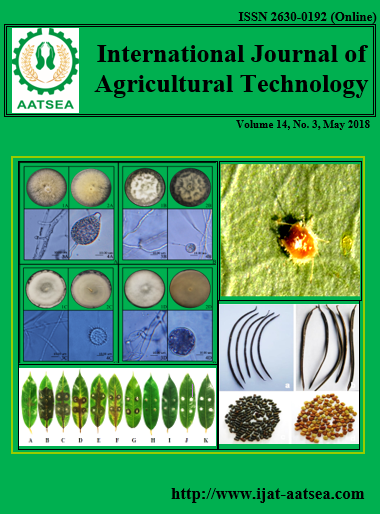Biodiversity and Investigating Pathogenic Levels of Endogenous Strains of Pandora neaoaphidis Collected from Cruciferous Crops in Northern Thailand
Main Article Content
Abstract
The biodiversity and virulence of aphid pathogen: Pandora (Erynia) neoaphidis from cruciferous crops covering thirteen districts in Chiang Mai, Lamphun and Lampang provinces, Northern of Thailand were evaluated. Base on phenotypic level, 128 isolates of P. neoaphidis were collected from various survey location. The result showed that natural occurrence pathogenicity rate of P. neoaphidis was in the range of 11 to 93.13% with an average of 41.22%±12.63. Three isolates (2.3%) showed pathogenic activity higher than 90% including Eyn13 was the most activity of 93.14±4.54 % followed by those of Eyn12 and Eyn14 which had the action of 91.68±5.13 % and 90.30%±23.57, respectively.In addition, these of Eyn04, Eyn17, Eyn16, Eyn20, Eyn15, Eyn24, Eyn02, Eyn18 and Eyn01 showed the natural pathogenic action in the range of 85.89±13.07 to 73.42±9.72, respectively. Contrary, pathogenicity rate of four isolates of P. neoaphidis (Eyn59, Eyn85, Eyn110 and Eyn62) were very low less than 15% which Eyn62 was the lowest (11.13%±5.94). As a whole, 39 isolates of P. neoaphidis established aphid pathogenic traits at 21 to 30% followed by those of 22 isolates at 31-40%, whereas the innate of 52 isolates had pathogenicity in the range of 40 to 100%, respectively.
Article Details

This work is licensed under a Creative Commons Attribution-NonCommercial-NoDerivatives 4.0 International License.
References
Bänziger, H. (1976). Keys for the identification of aphids (Homoptera) I, Winged aphids of species economically important in Thailand. Department of Agriculture and UNDP/FAO. Plant Protection Service Technical Bulletin No 36, Bangkok.
Bänziger, H. (1977). Keys for the identification of aphids (Homoptera) II. II. Field identification No. 37. Department of Agriculture and UNDP/FAO, Bangkok.
Barber, M. D., Moores, G. D., Tatchell, G. M., Vice, W. E. and Denholm, I. (1999). Insecticide resistance in the currant-lettuce aphid, Nasonovia ribisnigri (Hemiptera: Aphididae) in the UK. Bulletin of Entomological Research 89:17-23.
Blackman, R. L. and Eastop, V. F. (2000). Aphids on the world’ crops: An identification and information guide. New York: John Wiley & Sons.
Chen, B., Li, Z. Y. and Feng, M. G. (2008). Occurrence of entomopathogenic fungi in migratory alate aphids in Yunnan Province of China Province of China. Biocontrol 53:317-326. doi: 10.1007/s10526-006-9063-z.
Copping, L. G. (2009). The manual of biocontrol agents (4th ed.). Hampshire, British Crop Protection Council, UK.
El-Defrawi, G. M. M. and El-Harty, E. H. (2010). Injury levels and yield loss model for the cowpea aphid Aphis craccivora Koch on Vicia faba (L). Available source: http://faculty.ksu.edu.sa/ehab/Pictures.
Gould, H. J. (1966). Organophosphorus insecticide resistance in aphids on year-round chrysantimums. Plant Pathology 15:109-112. DOI: 10.1111/j.1365-3059.1966. tb00325.x
Hoskin, C. J., Megan, H., McDonald, K. R. and Craig, M. (2005). Reinforcement drive rapid allopatic. Nature, 437 (7063), 1353–1356. Available source: http://www.aphidwatch. com/ lettuce/aphid-resis2.pdf, June 6, 2016. doi:10.1038/nature04004.
Leskovar, D. I. and Black, M. C. (1994). White rust infection leaf chlorosis in relation to crop strategies in spinach. Journal Environmental and Experimental Botany 34:363-370. doi:10.1016/0098-8472(94)90018-3.
McLeod, P. J., Steinkraus, D. C., Correll, J. C. and Morelock, T. E. (1998). Prevalence of Erynia neoaphidis (Entomophthorales: Entomopthoraceae) infection of green peach aphid (Homoptera: Aphididae) on spinach in the Arkansas River Valley. Environmental Entomology 3:796-800.
Moore, M. S., Bayer (NZ) Ltd. and Hagerty G. C. (2010). Preliminary advice on minimizing insecticide resistance in lettuce aphids. Available source: http://www.aphidwatch.com /lettuce/aphid-resis2.pdf, July 5, 2016.
Nielsen, C., Jensen, A. B. and Eilenberg, J. (2007). Survival of entomophthoralean fungi infecting aphids and higher flies during unfavourable conditions and implications for conservation biological control. In: Ekesi, S. and Maniania, NK. (Eds), Use of Entomopathogenic Fungi in Biological Pest Management. Research Signpost Trivandrum, India.
Owain, R. E., Franzmann, B., Thackray, D. and Micic, S. (2008). Insecticide resistance and implications for future aphid management in Australian grains and pastures: a review. Journal of Experimental Agriculture 48(12): 1523–1530. Available source: http://dx.doi.org/10.1071/EA07426, May 8, 2015.
Rirkviree, S. (1967). Some aphids of economic importance in Thailand. (Bachelor’s thesis). Kasetsart University.
Saengyot, S., Channarong, D., Woravan, C., Warunee, S. and Porchai, D. (2008). Survey, collecting and evaluating of microbial for insect control and weed control. National Biological Control Research Center, Bangkok.
Sánchez, M. V., Agüero, R. and Rivera, C. (2001). Host plants of Aphis gossypii (Aphididae), vector of virus of Cucumis melo melon (Cucurbitaceae) in Costa Rica. Revista de Biología Tropical 1:305-11.
Shah, P. A. and Pell, J. K. (2003). Entomopathogenic fungi as biological control agents. Applied Microbiology and Biotechnology 61:413-423. DOI 10.1007/s00253-003-1240-8.
Sierotzki, H., Camastral, F., Shah, P., Aebi, M. and Tuor, U. (2000). Biological characteristics of selected Erynia neoaphidis isolates. Mycological research 2:213-219.
Stufkens, M. A. W., Walker, G. P. and Martin, N. A. (2005). Lettuce aphid resistance management and prevention Strategy. In N.A. Martin, Beresford Palmerston North Pesticide Resistance: Prevention and Management Strategies 2005 Hastings. New Zealand Plant Protection Society Inc, New Zealand.
Surendra K. D. and Semtner, P. J. (2006). Within-Plant Distribution of Pandora neoaphidis (Zygomycetes: Entomophthorales) in Populations of the Tobacco-Feeding Form of Myzus persicae (Homoptera: Aphididae) on flue-cured Tobacco. Journal of Agricultural and Urban Entomology 2:65-76.
Wang, R. Y., Powell, G., Hardie, J. and Pirone, T. P. (1998). Role of the helper component in vector-specific transmission of potyviruses. Journal of Clinical Virology 79:1519-1524.
Wongsiri, N. (1991). List of insect, mite and other zoological pests of economic plants in Thailand. Technical Bulletin. Entomology and Zoology Division, Department of Agriculture, Bangkok.


